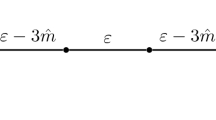Abstract
The dissemination of opinions is a very important phenomenon in modern societies because it shapes politics, policies and then guides the evolution of societies in the future. The scheme is very simple: an opinion is transmitted by a leader to other people in his (her) neighborhood. People can be convinced or not and so, in turn, they convey their updated opinion (or their previous one) to their neighbors. This paper presents a computational framework based on a set binary local rules that have the capability to model the transmission of opinion between neighbors. Several neighborhood types are considered, such as 4- and 8-neighbours and knight (chess) neighbors. Different behavioral patterns are analyzed in relation to rule type, neighborhood type, and leader type.
Access this chapter
Tax calculation will be finalised at checkout
Purchases are for personal use only
Similar content being viewed by others
References
Guan, Xiaolan, Zhang, Zhenji, Zhang, Shugang: Evolution Mechanism of the Ecological Dissemination System of Internet Public Opinion. In: Zhang, Zhenji, Shen, Zuojun Max, Zhang, Juliang, Zhang, Runtong (eds.) LISS 2014, pp. 1769–1776. Springer, Heidelberg (2015). doi:10.1007/978-3-662-43871-8_255
Alvarez-Galvez, J.: Network models of minority opinion spreading: using agent-based modeling to study possible scenarios of social contagion. Soc. Sci. Comput. Rev. 34, 567–581 (2016)
Kenneth, J., et al.: On the coevolution of stereotype, culture, and social relationships: an agent-based model. Soc. Sci. Comput. Rev. 32, 295–311 (2013)
O’Sullivan, D.: Changing neighborhoods-neighborhoods changing. A framework for spatially explicit agent-based models of social systems. Sociol. Methods Res. 37(4), 498–530 (2009)
Xia, H., et al.: Opinion dynamics. Int. J. Knowl. Syst. 2, 72–91 (2011)
De Groot, M.H.: Reaching a consensus. J. Am. Stat. Assoc. 69(345), 118–121 (1974)
Hegselmann, R., Krause, U.: Opinion dynamics and bounded confidence models, analysis, and simulation. J. Artif. Soc. Soc. Simul. 5(3) (2002)
Chatterjee, S., Durrett, R.: Contact processes on random graphs with power law decree distributions have critical value 0. Ann. Probab. 37(6), 2332–2356 (2009)
Remenik, D.: The contact process in a dynamic random environment. Ann. Appl. Probab. 18(6), 2392–2420 (2008)
Pasia, G., Yagerb, R.R.: Modeling the concept of majority opinion in group decision making. Inf. Sci. 176(4), 390–414, Springer (2006)
Kountouriotisa, V., et al.: An agent-based crowd behaviour model for real time crowd behaviour simulation. Pattern Recognit. Lett. 44, 30–38, Elsevier (2014)
Reynolds, C.W.: Flocks, herds, and schools: a distributed behavioral model. Comput. Graph. 21(4), 25–34 (1987)
Signes Pont, M.T., et al.: A. The susceptible-infectious model of disease expansion analyzed under the scope of connectivity and neighbor rules. In: Second International Conference on Computer Science, Information Technology and Applications Proceedings, pp. 1–10, Zürick (2017)
Signes Pont, M.T., et al.: The susceptible-infectious-recovered (SIR) model of disease expansion: a new approach. In: Proceeding of 17th Conference on Mathematical Modelling in Engineering & Human Behaviour (2017)
Author information
Authors and Affiliations
Corresponding author
Editor information
Editors and Affiliations
Rights and permissions
Copyright information
© 2017 Springer International Publishing AG
About this paper
Cite this paper
Pont, M.T.S., Mora, H., Castillo, A.C., Hidalgo, M.N. (2017). Opinion Dissemination Computational Model. In: Ochoa, S., Singh, P., Bravo, J. (eds) Ubiquitous Computing and Ambient Intelligence. UCAmI 2017. Lecture Notes in Computer Science(), vol 10586. Springer, Cham. https://doi.org/10.1007/978-3-319-67585-5_82
Download citation
DOI: https://doi.org/10.1007/978-3-319-67585-5_82
Published:
Publisher Name: Springer, Cham
Print ISBN: 978-3-319-67584-8
Online ISBN: 978-3-319-67585-5
eBook Packages: Computer ScienceComputer Science (R0)




